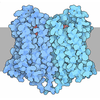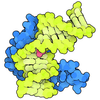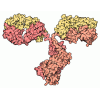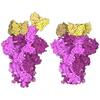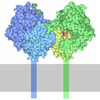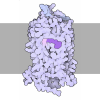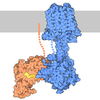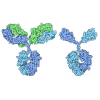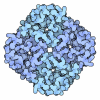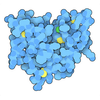[English] 日本語
 Yorodumi
Yorodumi- PDB-8xqe: Cryo-EM structure of human dimeric APJR-Gi complex with apelin-13. -
+ Open data
Open data
- Basic information
Basic information
| Entry | Database: PDB / ID: 8xqe | ||||||||||||||||||||||||
|---|---|---|---|---|---|---|---|---|---|---|---|---|---|---|---|---|---|---|---|---|---|---|---|---|---|
| Title | Cryo-EM structure of human dimeric APJR-Gi complex with apelin-13. | ||||||||||||||||||||||||
 Components Components |
| ||||||||||||||||||||||||
 Keywords Keywords | SIGNALING PROTEIN / GPCR / APJR / Gi / Apelin-13 / Dimeric | ||||||||||||||||||||||||
| Function / homology |  Function and homology information Function and homology informationapelin receptor binding / positive regulation of corticotropin-releasing hormone secretion / positive regulation of corticotropin secretion / : / apelin receptor activity / apelin receptor signaling pathway / mechanoreceptor activity / regulation of gap junction assembly / positive regulation of G protein-coupled receptor internalization / vascular associated smooth muscle cell differentiation ...apelin receptor binding / positive regulation of corticotropin-releasing hormone secretion / positive regulation of corticotropin secretion / : / apelin receptor activity / apelin receptor signaling pathway / mechanoreceptor activity / regulation of gap junction assembly / positive regulation of G protein-coupled receptor internalization / vascular associated smooth muscle cell differentiation / atrioventricular valve development / regulation of body fluid levels / positive regulation of heat generation / venous blood vessel development / negative regulation of fibroblast growth factor receptor signaling pathway / positive regulation of heart contraction / positive regulation of cardiac muscle hypertrophy in response to stress / drinking behavior / endocardial cushion formation / positive regulation of blood vessel endothelial cell proliferation involved in sprouting angiogenesis / regulation of the force of heart contraction / coronary vasculature development / adult heart development / vasculature development / negative regulation of systemic arterial blood pressure / G protein-coupled peptide receptor activity / positive regulation of vascular endothelial cell proliferation / aorta development / negative regulation of cardiac muscle hypertrophy in response to stress / negative regulation of vasoconstriction / ventricular septum morphogenesis / blood vessel development / heart looping / negative regulation of vascular associated smooth muscle cell proliferation / positive regulation of phosphorylation / vasculogenesis / positive regulation of heart rate / negative regulation of blood pressure / gastrulation / lactation / G protein-coupled serotonin receptor binding / Peptide ligand-binding receptors / positive regulation of release of sequestered calcium ion into cytosol / electron transport chain / G protein-coupled receptor activity / hormone activity / adenylate cyclase-inhibiting G protein-coupled receptor signaling pathway / positive regulation of miRNA transcription / adenylate cyclase-modulating G protein-coupled receptor signaling pathway / G-protein beta/gamma-subunit complex binding / Olfactory Signaling Pathway / Activation of the phototransduction cascade / G beta:gamma signalling through PLC beta / Presynaptic function of Kainate receptors / Thromboxane signalling through TP receptor / G protein-coupled acetylcholine receptor signaling pathway / positive regulation of angiogenesis / Activation of G protein gated Potassium channels / Inhibition of voltage gated Ca2+ channels via Gbeta/gamma subunits / G-protein activation / Prostacyclin signalling through prostacyclin receptor / G beta:gamma signalling through CDC42 / Glucagon signaling in metabolic regulation / G beta:gamma signalling through BTK / Synthesis, secretion, and inactivation of Glucagon-like Peptide-1 (GLP-1) / ADP signalling through P2Y purinoceptor 12 / photoreceptor disc membrane / Sensory perception of sweet, bitter, and umami (glutamate) taste / Glucagon-type ligand receptors / Adrenaline,noradrenaline inhibits insulin secretion / Vasopressin regulates renal water homeostasis via Aquaporins / Glucagon-like Peptide-1 (GLP1) regulates insulin secretion / G alpha (z) signalling events / cellular response to catecholamine stimulus / ADP signalling through P2Y purinoceptor 1 / ADORA2B mediated anti-inflammatory cytokines production / G beta:gamma signalling through PI3Kgamma / adenylate cyclase-activating dopamine receptor signaling pathway / Cooperation of PDCL (PhLP1) and TRiC/CCT in G-protein beta folding / GPER1 signaling / Inactivation, recovery and regulation of the phototransduction cascade / cellular response to prostaglandin E stimulus / G-protein beta-subunit binding / heterotrimeric G-protein complex / G alpha (12/13) signalling events / sensory perception of taste / extracellular vesicle / signaling receptor activity / signaling receptor complex adaptor activity / Thrombin signalling through proteinase activated receptors (PARs) / heart development / retina development in camera-type eye / regulation of gene expression / GTPase binding / Ca2+ pathway / fibroblast proliferation / High laminar flow shear stress activates signaling by PIEZO1 and PECAM1:CDH5:KDR in endothelial cells / angiogenesis / cell cortex / G alpha (i) signalling events Similarity search - Function | ||||||||||||||||||||||||
| Biological species |  Homo sapiens (human) Homo sapiens (human) | ||||||||||||||||||||||||
| Method | ELECTRON MICROSCOPY / single particle reconstruction / cryo EM / Resolution: 3.48 Å | ||||||||||||||||||||||||
 Authors Authors | Yue, Y. / Liu, L.E. / Wu, L.J. / Xu, F. | ||||||||||||||||||||||||
| Funding support | 1items
| ||||||||||||||||||||||||
 Citation Citation |  Journal: Nat Commun / Year: 2025 Journal: Nat Commun / Year: 2025Title: Structural insights into the regulation of monomeric and dimeric apelin receptor. Authors: Yang Yue / Lier Liu / Lijie Wu / Chanjuan Xu / Man Na / Shenhui Liu / Yuxuan Liu / Fei Li / Junlin Liu / Songting Shi / Hui Lei / Minxuan Zhao / Tianjie Yang / Wei Ji / Arthur Wang / Michael ...Authors: Yang Yue / Lier Liu / Lijie Wu / Chanjuan Xu / Man Na / Shenhui Liu / Yuxuan Liu / Fei Li / Junlin Liu / Songting Shi / Hui Lei / Minxuan Zhao / Tianjie Yang / Wei Ji / Arthur Wang / Michael A Hanson / Raymond C Stevens / Jianfeng Liu / Fei Xu /   Abstract: The apelin receptor (APJR) emerges as a promising drug target for cardiovascular health and muscle regeneration. While prior research unveiled the structural versatility of APJR in coupling to Gi ...The apelin receptor (APJR) emerges as a promising drug target for cardiovascular health and muscle regeneration. While prior research unveiled the structural versatility of APJR in coupling to Gi proteins as a monomer or dimer, the dynamic regulation within the APJR dimer during activation remains poorly understood. In this study, we present the structures of the APJR dimer and monomer complexed with its endogenous ligand apelin-13. In the dimeric structure, apelin-13 binds exclusively to one protomer that is coupled with Gi proteins, revealing a distinct ligand-binding behavior within APJR homodimers. Furthermore, binding of an antagonistic antibody induces a more compact dimerization by engaging both protomers. Notably, structural analyses of the APJR dimer complexed with an agonistic antibody, with or without Gi proteins, suggest that G protein coupling may promote the dissociation of the APJR dimer during activation. These findings underscore the intricate interplay between ligands, dimerization, and G protein coupling in regulating APJR signaling pathways. | ||||||||||||||||||||||||
| History |
|
- Structure visualization
Structure visualization
| Structure viewer | Molecule:  Molmil Molmil Jmol/JSmol Jmol/JSmol |
|---|
- Downloads & links
Downloads & links
- Download
Download
| PDBx/mmCIF format |  8xqe.cif.gz 8xqe.cif.gz | 270.8 KB | Display |  PDBx/mmCIF format PDBx/mmCIF format |
|---|---|---|---|---|
| PDB format |  pdb8xqe.ent.gz pdb8xqe.ent.gz | 209.4 KB | Display |  PDB format PDB format |
| PDBx/mmJSON format |  8xqe.json.gz 8xqe.json.gz | Tree view |  PDBx/mmJSON format PDBx/mmJSON format | |
| Others |  Other downloads Other downloads |
-Validation report
| Summary document |  8xqe_validation.pdf.gz 8xqe_validation.pdf.gz | 1.4 MB | Display |  wwPDB validaton report wwPDB validaton report |
|---|---|---|---|---|
| Full document |  8xqe_full_validation.pdf.gz 8xqe_full_validation.pdf.gz | 1.4 MB | Display | |
| Data in XML |  8xqe_validation.xml.gz 8xqe_validation.xml.gz | 55.4 KB | Display | |
| Data in CIF |  8xqe_validation.cif.gz 8xqe_validation.cif.gz | 83.9 KB | Display | |
| Arichive directory |  https://data.pdbj.org/pub/pdb/validation_reports/xq/8xqe https://data.pdbj.org/pub/pdb/validation_reports/xq/8xqe ftp://data.pdbj.org/pub/pdb/validation_reports/xq/8xqe ftp://data.pdbj.org/pub/pdb/validation_reports/xq/8xqe | HTTPS FTP |
-Related structure data
| Related structure data |  38574MC 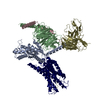 8xqfC  8xqiC  8xqjC  8z74C 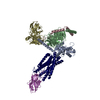 8z7jC M: map data used to model this data C: citing same article ( |
|---|---|
| Similar structure data | Similarity search - Function & homology  F&H Search F&H Search |
- Links
Links
- Assembly
Assembly
| Deposited unit | 
|
|---|---|
| 1 |
|
- Components
Components
-Protein , 2 types, 3 molecules ARQ
| #1: Protein | Mass: 40616.211 Da / Num. of mol.: 1 Source method: isolated from a genetically manipulated source Source: (gene. exp.)  Homo sapiens (human) / Gene: GNAI1 / Production host: Homo sapiens (human) / Gene: GNAI1 / Production host:  Trichoplusia ni (cabbage looper) / References: UniProt: A0A096MZM0 Trichoplusia ni (cabbage looper) / References: UniProt: A0A096MZM0 |
|---|---|
| #4: Protein | Mass: 54312.578 Da / Num. of mol.: 2 Source method: isolated from a genetically manipulated source Source: (gene. exp.)  Homo sapiens (human) / Gene: cybC, APLNR, AGTRL1, APJ / Production host: Homo sapiens (human) / Gene: cybC, APLNR, AGTRL1, APJ / Production host:  Trichoplusia ni (cabbage looper) / References: UniProt: P0ABE7, UniProt: P35414 Trichoplusia ni (cabbage looper) / References: UniProt: P0ABE7, UniProt: P35414 |
-Guanine nucleotide-binding protein ... , 2 types, 2 molecules BC
| #2: Protein | Mass: 37416.930 Da / Num. of mol.: 1 Source method: isolated from a genetically manipulated source Source: (gene. exp.)  Homo sapiens (human) / Gene: GNB1 / Production host: Homo sapiens (human) / Gene: GNB1 / Production host:  Trichoplusia ni (cabbage looper) / References: UniProt: P62873 Trichoplusia ni (cabbage looper) / References: UniProt: P62873 |
|---|---|
| #3: Protein | Mass: 7861.143 Da / Num. of mol.: 1 Source method: isolated from a genetically manipulated source Source: (gene. exp.)  Homo sapiens (human) / Gene: GNG2 / Production host: Homo sapiens (human) / Gene: GNG2 / Production host:  Trichoplusia ni (cabbage looper) / References: UniProt: P59768 Trichoplusia ni (cabbage looper) / References: UniProt: P59768 |
-Antibody / Protein/peptide , 2 types, 2 molecules SD
| #5: Antibody | Mass: 27784.896 Da / Num. of mol.: 1 Source method: isolated from a genetically manipulated source Source: (gene. exp.)  Homo sapiens (human) / Production host: Homo sapiens (human) / Production host:  Trichoplusia ni (cabbage looper) Trichoplusia ni (cabbage looper) |
|---|---|
| #6: Protein/peptide | Mass: 1554.860 Da / Num. of mol.: 1 Source method: isolated from a genetically manipulated source Source: (gene. exp.)  Homo sapiens (human) / Gene: APLN, APEL / Production host: Homo sapiens (human) / Gene: APLN, APEL / Production host:  Trichoplusia ni (cabbage looper) / References: UniProt: Q9ULZ1 Trichoplusia ni (cabbage looper) / References: UniProt: Q9ULZ1 |
-Details
| Has protein modification | Y |
|---|
-Experimental details
-Experiment
| Experiment | Method: ELECTRON MICROSCOPY |
|---|---|
| EM experiment | Aggregation state: PARTICLE / 3D reconstruction method: single particle reconstruction |
- Sample preparation
Sample preparation
| Component | Name: dimeric APJR-Gi complex with apelin-13 / Type: COMPLEX / Entity ID: all / Source: RECOMBINANT |
|---|---|
| Source (natural) | Organism:  Homo sapiens (human) Homo sapiens (human) |
| Source (recombinant) | Organism:  Trichoplusia ni (cabbage looper) Trichoplusia ni (cabbage looper) |
| Buffer solution | pH: 7.4 |
| Specimen | Embedding applied: NO / Shadowing applied: NO / Staining applied: NO / Vitrification applied: YES |
| Vitrification | Cryogen name: ETHANE |
- Electron microscopy imaging
Electron microscopy imaging
| Experimental equipment |  Model: Titan Krios / Image courtesy: FEI Company |
|---|---|
| Microscopy | Model: FEI TITAN KRIOS |
| Electron gun | Electron source:  FIELD EMISSION GUN / Accelerating voltage: 300 kV / Illumination mode: FLOOD BEAM FIELD EMISSION GUN / Accelerating voltage: 300 kV / Illumination mode: FLOOD BEAM |
| Electron lens | Mode: BRIGHT FIELD / Nominal defocus max: 2200 nm / Nominal defocus min: 700 nm |
| Image recording | Electron dose: 60 e/Å2 / Film or detector model: GATAN K3 BIOQUANTUM (6k x 4k) |
- Processing
Processing
| EM software | Name: PHENIX / Category: model refinement | ||||||||||||||||||||||||
|---|---|---|---|---|---|---|---|---|---|---|---|---|---|---|---|---|---|---|---|---|---|---|---|---|---|
| CTF correction | Type: PHASE FLIPPING ONLY | ||||||||||||||||||||||||
| 3D reconstruction | Resolution: 3.48 Å / Resolution method: FSC 0.143 CUT-OFF / Num. of particles: 24309 / Symmetry type: POINT | ||||||||||||||||||||||||
| Refine LS restraints |
|
 Movie
Movie Controller
Controller







 PDBj
PDBj
